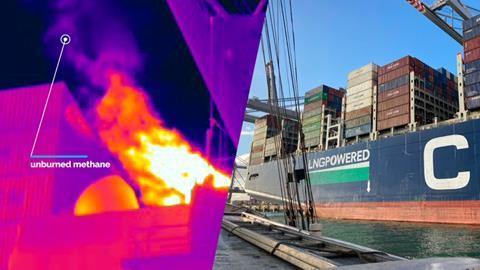Transport & Environment recently released colourful images of gas and heat plumes from the stacks of two vessels, claiming to have exposed “Europe’s dirty secret at sea,” but industry organisation SEA-LNG is disappointed with what it sees as misinformation.
Colourful rhetoric aside, T&E released images that show heat and gas emissions from the exhaust stacks of two ships – the CMA CGM Louvre, built in 2020, and the Eco-Delta, built in 2018. They used an infrared camera with a special filter and say that the bright light near the exhaust stack indicates a heat source. As the plume moves away from the heated exhaust stack, T&E has cited a consultancy as confirming the presence of uncombusted or partially combusted hydrocarbons.
“T&E has released images that purport to show heat and gas emissions from the exhaust stacks of the CMA CGM Louvre (pictured) and the Eco-Delta.” “/ /
T&E has released images that purport to show heat and gas emissions from the exhaust stacks of the CMA CGM Louvre (pictured) and the Eco-Delta.
They reference a description of the GF320 camera technique which states: “Besides the ability to measure and detect heat differences, the GF320 contains a special filter that allows it to detect infrared energy in the 3.2 – 3.4 micrometer waveband. In addition to methane, other hydrocarbon gases of interest have infrared energy transmittance in this range.”
T&E goes on to estimate that about 80% of LNG today is burned in ship engines with worse total greenhouse gas emissions than engines running on heavy fuel oil. “Emission plumes that go up in the sky and remain there for a long time are an indication of this.”
T&E warns that without sustainability safeguards EU regulations will simply lock in LNG as the cheapest alternative to heavy fuel oil. Delphine Gozillon, shipping officer at T&E, said: “In promoting LNG ships, European policymakers are locking us into a future of fossil gas.”
Ill-informed speculation
The Motorship canvassed the views of Steve Esau, Chief Operating Officer at SEA-LNG, and asked: is there any doubt that the infrared plumes relate to LNG?
“T&E claims that the infrared photos and video show methane emissions but does not provide any evidence for this. It does not share the ‘peer reviewed analysis’ which apparently supports these claims. Further, it does not attempt to quantify the alleged methane emissions nor does it provide details of the engines in operation at the time or their operating conditions. Any comments would be speculative and cannot help to move discussion of GHG emissions in shipping forward.”
Regarding T&E’s comparison between LNG and heavy fuel oil burning engines, he says: “T&E implies that the worst performing LNG-fuelled engines in-service in terms of methane slip are representative of the future LNG-fuelled fleet. We are confident in the peer-reviewed analysis published in 2021 by ESG lifecycle experts, Sphera, based on primary data from all major engine manufacturers. This study shows that LNG-fuelled engines being sold by engine manufacturers, now, have GHG benefits compared with current oil-based engines of between 20% to 30% for 2-stroke slow speed engines, and 11% to 21% for 4-stroke medium speed engines, inclusive of methane slip. With the ongoing steady technological advancements, the GHG benefits will only improve in the future versions of the LNG fuelled engines as the technology is more widely adopted by the shipping sector.”
He continues: “LNG-fuelled engines are available now which have minimal levels of slip: these engines represent at least half the LNG new build order book. For those technologies for which slip remains an issue, levels have fallen four-fold since the early 2000s and engine manufacturers continue to identify technological pathways that will mean all LNG-fuelled engines have minimal levels of methane slip by 2030, if not sooner.”
LNG is the only widely available marine fuel that immediately cuts GHG emissions compared with traditionally powered vessels, Esau says. “The LNG pathway that SEA-LNG supports also offers a route to net-zero greenhouse gas emissions for the shipping industry through the continual introduction of available bioLNG and ultimately renewable synthetic LNG. Emission-neutral bioLNG is already being bunkered in Europe and North America. We continue to be confident that bioLNG and renewable synthetic LNG will be an integral part of a basket of net-zero emission marine fuels in the future.
“SEA-LNG is disappointed to see the ongoing campaign of misinformation that misrepresents the progress the industry has made, and is continuing to make, to reduce slip. Sensationalist claims lacking scientific evidence are a transparent attempt to distract the industry from investing in LNG – a solution that can deliver immediate GHG emissions reductions and provide a low risk, incremental pathway for full decarbonisation of the maritime sector.”






